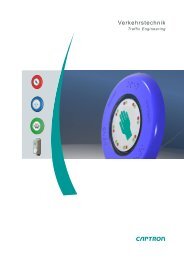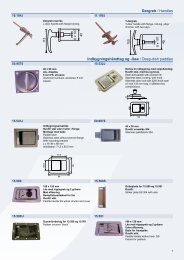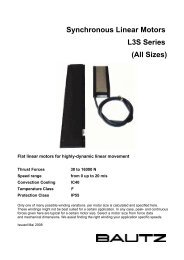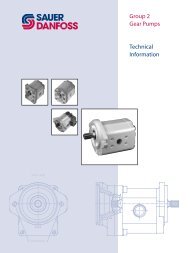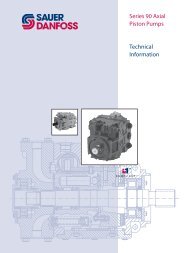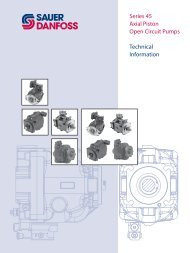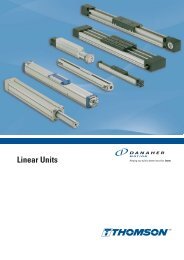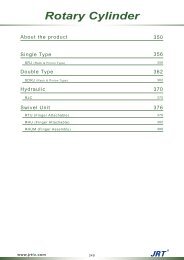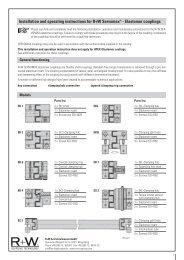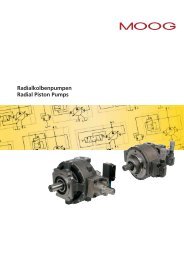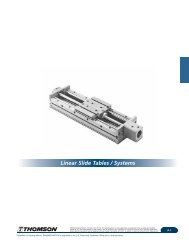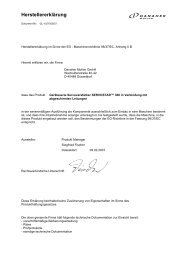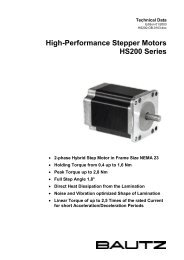Create successful ePaper yourself
Turn your PDF publications into a flip-book with our unique Google optimized e-Paper software.
Application Assistance (Continued)<br />
Leadscrew System<br />
Variable Definitions:<br />
L = length (in) g = 386 in/sec 2<br />
d = diameter (in) F = Force (lb)<br />
J = inertia (lb-in 2 ) E = Efficiency (as a decimal)<br />
ρ = Screw lead (in/rev) w = weight of load (lb)<br />
Step 1: Calculate Load Inertia (J total load ):<br />
J load = w * ρ 2 * ( 1/2 π) 2<br />
J screw = π / 32 * d 4 * L * r or 1/2 * w * r 2<br />
J total load = J load + J screw<br />
Step 2: Calculate Total Inertia (J total ):<br />
J total = J total load + J motor<br />
J motor is found in the Rotor Inertia table at the end of this<br />
section.<br />
Note: If J total load > 10 * J motor , then this motor will not be<br />
applicable.<br />
Step 3: Calculate the Torque in the System (T L ):<br />
For a Horizontal leadscrew application, the formula for the<br />
system torque is: T L = (F * ρ) / (E * 2π)<br />
For a Vertical leadscrew application, the formula for the<br />
system torque is: T L = (((g * w) +/- F) * ρ) / (E * 2π)<br />
where E is the efficiency of the system and F any force that<br />
opposes the movement of the load with the<br />
exception of friction or gravity.<br />
Step 4: Calculate the Torque Required to Obtain Base<br />
Speed (T b ):<br />
T b = J total* V b 2 * 0.00032<br />
Step 5: Calculate Torque Required to Accelerate the System<br />
(T a ):<br />
T a = J total ((V f – V b ) / t acc ) * 0.00064<br />
t acc is the rate of acceleration.<br />
Cylinder/Rod System<br />
Variable Definitions:<br />
r = radius (in) r i = inner radius (in)<br />
r o = outer radius (in)<br />
L = length (in) L = length (in)<br />
w = weight of cyl (lb) w = weight of cyl (lb)<br />
J = inertia (lb-in 2 ) J = inertia (lb-in 2 )<br />
V b = Base speed (<strong>step</strong>s/sec) V b = Base speed (<strong>step</strong>s/sec)<br />
V f = Final speed (<strong>step</strong>s/sec) V f = Final speed (<strong>step</strong>s/sec)<br />
Step 1: Calculate Load Inertia (J load ):<br />
Solid Cylinder:<br />
Inertia at Axis A: J load = 1/2 * w * r 2<br />
Inertia at Axis B: J load = 1/12 * w(3 r 2 + L 2 )<br />
Hollow Cylinder:<br />
Inertia at Axis A: J load = 1/2 * w(r o 2 + r i 2 )<br />
Inertia at Axis B: J load = 1/4 * w(r o 2 + r i 2 + h / 3)<br />
Step 2: Calculate Total Inertia (J total ):<br />
Very simply: J total = J load + J motor<br />
J motor is found in the Rotor Inertia table at the end of this<br />
section.<br />
Note: If J load > 10 * J motor , then this motor will not be<br />
applicable.<br />
Step 3: Calculate the Torque<br />
in System (T L ):<br />
T L = F * r where F is the<br />
Force in Pounds.<br />
STEP MOTORS<br />
Step 4: Calculate Torque Required to Reach Base Speed(T b ):<br />
T b = J total* V b 2 * 0.00032<br />
Step 5: Calculate Torque Required to Accelerate the System<br />
(T a ):<br />
T a = J total ((V f – V b ) / t acc ) * 0.00064<br />
www.DanaherMotion • 704-588-5693<br />
25



